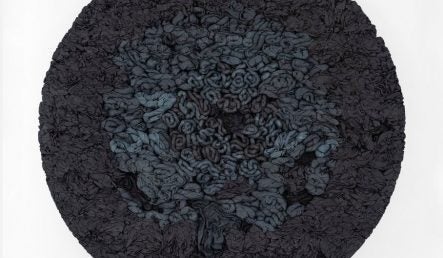Materiality

Manish Nai solo show.
The Galerie Karsten Greve presents Materiality, a new solo exhibit by the Indian artist Manish Nai; born in Gujarat state in 1980. Having been with the gallery since 2009, for this particular occasion he would like to showcase a select course of recent (2014 – 2018) works that include sculpture and installation, but equally so drawing, painting and photography.
Manish Nai began his career in the early 2000s at a time when the Indian contemporary art market was enjoying an upswing, and was especially enamoured with figurative and chromatic art. By using an audacious clean-lined, spare approach to shape and colour, he follows in the wake of Minimalism and of western- tradition Abstraction to a greater extent than his compatriot artists. In fact, Manish Nai conceives his work as counterpoint to the flourishing bustle of India’s cities, thus offering onlookers objects that allow the mind to re-centre itself in silence that is replete with spirituality. Nevertheless, in Nai’s work, a geometrically-oriented aesthetic is paired with a range of media that hold deep-seated cultural significance. As is the case with the Arte Povera he admires, cultural ties play an important role in his work. The watchful eye he trains on the socio-economic and cultural situation in his country is indeed at the crux of his creative endeavours, yet this does not produce militant art. The artist rebuffs all political judgment, concentrating solely on the effects of different media and trompe l’oeil. These are particularly noticeable in his pastel drawings, but also in two wall- panel series made with mosquito screens. In one of these, overlapping layers create an optical illusion that resembles shimmering silk: whereas in the other, watercolour washes give unprecedented depth to colour that emanates from amongst the mesh links.
The artist’s interest in the aesthetic potential of everyday objects is also apparent in his use of compressed burlap board, cardboard, and newspaper: the most emblematic elements of his body of work. Straddling the border between painting and sculpture, Manish Nai’s way of twisting and compressing his materials infuses these rough surfaces with outstanding three-dimensional effect. Reminiscent of Alberto Burri’s creative endeavours, the Indian artist’s decision to harness the physical qualities of such stiff, rough fabric in its natural tones, also serves to firmly anchor his work in his country’s economic and social history. Ever since colonial times, the heart of the Indian economy has indeed come to depend upon the production of burlap and canvas bags for the food trade. However, the recent global economic crisis significantly impacted this sector, forcing many business owners, including the artist’s father, to close shop. This situation provided the artist with access to a raw material that has become prevalent in his artistry. Tinting the burlap indigo blue adds a spiritual dimension to the assembled clusters. Indeed, in Hinduism, as well as in Buddhism, this traditional, typically Indian pigment brims with symbolic power, remaining indelibly bound to the country’s political destiny. Especially true during the indigo producers’ revolt against the English settlers in 1917, during which time Gandhi developed his anti-violence standpoint, it has been fundamental in the struggle for independence, and in the creation of the Indian Republic. The artist brings forth the subcontinent’s ethnic diversity by utilising compacted newspapers, thus providing a sample of the more than one-hundred million copies sold daily in each of that country’s 22 official languages. And lastly, the aluminium panels recently added to the ‘cluster’ series behave similarly to the way Carl André’s installations did in the late 1960s: square surfaces of raw materials – aluminium, lead, magnesium, etc. – are laid directly on the ground horizontally, duly upending the way we expect painting and sculpture to be presented. By blending references to contemporary Western art’s abstract movements with his country’s collective life-experience, Manish Nai now makes highly evocative pieces.
With regards to form: the legacy of modernist experimentation has been fundamental for Manish Nai. Orthogonality, symmetry and modular repetition are recurring agents in his creations. The layout of the images in a grid is especially remarkable in the Billboards photograph series. These photographs depict the billboards that line Bombay’s roadways, which, due to the recent world recession, for the most part now stand blank. Depending on each advertiser’s needs, these huge palimpsests are made of an assembly of surfaces. Thanks to the way they have been photographed on the roadsides, the concept of serendipity, or happenstance becomes apparent in these compositions: the haphazard repositioning of surface areas means that traces of old ads remain, thus creating abstract compositions devoid of any ability to communicate, yet newly equipped with potential for totally abstract aesthetics. Spurred on by a sociological exploration of Mumbai’s public space, the artist manages to attain a sort of formal austerity by arranging modular elements. In her influential essay, Rosalind Krauss describes this grid-layout as a paradigm of modern art that carries two opposing elements: on the one hand, it is emblematic of materialistic thought – a rational and antimimetic configuration – while on the other, artists may use it as a means to reach a certain level of universal spirituality– thanks to its autotelic characteristics. Manish Nai’s works have therefore inherited this modernist viewpoint and convey what Rosalind Krauss has attributed to grid use: the ability to blend the opposing forces of reason and spirituality. Thanks to the socio-cultural references Nai makes to contemporary India, geometric shapes have become powerful vectors of communication in his pieces.